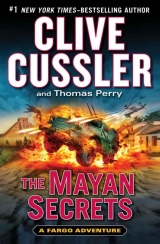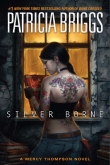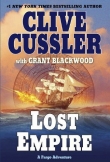
Текст книги "The Mayan Secrets"
Автор книги: Clive Cussler
Жанр:
Морские приключения
сообщить о нарушении
Текущая страница: 5 (всего у книги 20 страниц)
“Perfect,” said Caine. “Anything living begins to lose carbon 14 the minute it dies.”
“I’ll get them.” She went off to the other end of the room, disappeared through a door, and came back with the two plastic bags containing the wooden vessels, seeds, and husks.
Caine returned his attention to the pot. “This pot has a lid. The seal looks translucent, a bit like beeswax. Have you opened it?”
“No,” said Sam. “We realized that the minute we cleared the lava out of the doorway to the shrine, or whatever that building is, we exposed the man and his belongings to air and started the clock ticking. We didn’t want to do anything that might harm the pot. We’ve carried it around quite a bit, so we know the contents aren’t liquid and aren’t stone or metal, but it’s not empty. Something shifts around a little when you move it.”
“Shall we try to open it now?” asked Caine.
“We have a good place to do it,” Remi said. “In our remodeling, we’ve had the builders put in a climate-controlled room – low temperature, low humidity, no sunlight – just like a rare-book room in a library.”
“Wonderful,” said Caine.
“Follow me.” She led them to the door she had just emerged from, opened it, and turned on the light. The room had a long worktable and a few chairs and a wall of glass cabinets, all of them empty at the moment. In the corner of the room was a tall red tool chest on wheels that looked like the ones in auto mechanics’ shops.
Professor Caine carried the pot into the room and set it on the table. Sam wheeled the chest over and opened the top drawer, which held a collection of tools for working on small, delicate objects – brushes, tweezers, X-Acto knives, dental picks, awls, magnifiers, and high-intensity flashlights. There was also a box of sterile surgical gloves.
Caine put on gloves, chose a pick and tweezers to examine the seal and pull some of it off. He looked at it under a magnifier on a stand. “It seems to be a glue made from some kind of plant resin.” He switched to an X-Acto knife and methodically cut away the translucent substance from around the lid.
“What’s in there can’t be food. It’s glued shut,” said Remi.
“I don’t dare guess,” said Caine. “Archaeology is full of high hopes and pots that turn out to be full of mud.” He gripped the lid and twisted. “Interesting. I can turn the lid a little but not raise it. What it looks like is that he heated the pot a little, sealed it, and let it cool. That would produce a partial vacuum in it to keep the seal tight.”
“Just like canning,” said Remi. “Maybe it is food.”
“Now, I wonder how to get it open without breaking it.”
Sam said, “We could heat it a bit again to get the air inside to expand. Or we could take it up to a high altitude, where the air pressure is lower.”
“How could we warm it a bit without harming it?”
“If we do it evenly, the pot shouldn’t break,” said Sam.
“I agree,” Caine said.
“Another modification to the house: We put in a sauna,” said Remi.
They climbed the stairs to the second floor, and Sam entered the sauna, placed the pot on the wooden bench, then turned on the heat, slowly raising the temperature. At the end of ten minutes, he entered the sauna, wrapped the pot in a towel, and brought it out. He held the pot while Caine tried the lid. It came up and the pressure was equalized. Sam put the lid back on, and they all went back downstairs to the climate-controlled room.
“The big moment is coming,” said Remi.
“Don’t be disappointed if it’s just a mess of organic matter that used to be food,” said Caine. “Sometimes the best bits of information don’t look like much at first.”
Sam set the pot on the table. Caine, still wearing surgical gloves, took a deep breath and reached in. He pulled out a mass of what looked like dried weeds. “Packing material?”
He picked up a small flashlight and looked inside the pot. “Oh…” He stood up and peered down into the vessel. “Is it possible?”
“What is it?”
“It looks like a book,” he said. “A Mayan book.”
“Can you get it out?”
Caine put both hands into the vessel and lifted out a thick brownish rectangle and gently set it on the table. He reached out slowly with only his gloved index finger, lifted the outer layer an inch. His voice was a hoarse whisper. “Intact. I can’t believe it.” For a moment, he stood still, lost in thought. He withdrew his finger and only then seemed to notice the Fargos again.
His whole face brightened. “It’s a Mayan book, a codex. It seems to be undamaged. We have to take our time examining it because we don’t know how fragile it is, and there’s no way to know how many times a page can be turned or even touched.”
“I know they’re very rare,” Remi said.
“The rarest of all Western Hemisphere artifacts and by far the most valuable,” said Caine. “The Maya were the only people in the Americas who developed a complex system of writing and it’s good. They could write anything they could say. If they’d had the urge, they could have written novels, epic poems, histories. Maybe they did. There were once hundreds of thousands of these codices. Today there are only four that survived and made it into European museums – the Dresden Codex, the Madrid Codex, the Paris. And there’s also the Grolier Codex, but it’s so inferior to the others that many experts think it’s a forgery. But the first three are full of Mayan knowledge – mathematics, astronomy, cosmology, calendars. This could be the fifth.”
“You said there were once thousands,” said Remi.
“Hundreds of thousands, is a better estimate,” he said. “But there were two problems. The codices were painted on a fabric made from the bark of a wild fig tree called Ficus glabrata. The fabric was folded into pages and the pages painted with a white mixture like stucco. That gave the Maya white pages they could write on. They were better than papyrus, almost as good as paper.”
“What were the problems?”
“One was the climate. Most of Mayan country was humid jungle. When books get wet, they rot. Some codices were buried in tombs – some at Copán, some at Altun Ha in Belize, some at Uaxactún Guytan. The fig-bark fabric rotted, leaving little piles of painted stucco fragments too small and delicate to ever be pieced together. But the biggest problem arrived in ships.”
“The Spanish conquest,” said Sam.
“Mainly the priests. They made a point of destroying anything having to do with native religions. Mayan gods looked like devils to them. They burned every book they found and then searched every hiding place so no book could survive. This went on from the beginning of the Mayan conquest in the 1500s until the 1690s, when they took the last cities. That’s why only four are left.”
“And now five,” said Remi.
“It’s a spectacular find,” said Caine. “Do you have a place to put it where it will be safe?”
“We do,” said Sam. “We’ll lock it up tight.”
“Good. I’d like to get started on the dating process and then come back tomorrow to start examining the codex. Is that possible?”
“I’d say it’s mandatory,” said Sam. “We’re as curious as you are and we can’t satisfy our curiosity without you.”
Chapter 7
LA JOLLA
The next afternoon, Sam and Remi were waiting when David Caine arrived. After Sam and Remi took him into the climate-controlled room, Remi put on surgical gloves, opened one of the glass cabinets, and set the codex on the table. Caine sat for a moment, staring at the cover. “Before we begin,” he said, “the carbon dating is complete on the seeds and husks that were in the wooden bowls and on the wood itself. The samples all had 94.29 percent of their carbon 14. The wood and the plants died at about the same time, which is four hundred seventy-six years ago, in 1537.”
“Isn’t that sort of late for a classic Mayan?” asked Remi.
“It’s well into the end-time of the civilization. Most major classic cities had been abandoned by around 1000 A.D. Others stood until the Spanish got to them, beginning around 1524, when Pedro de Alvarado attacked the Maya with a huge army of native allies from Tlaxcala and Cholula. But there were many Mayan kingdoms that took a long time to be conquered. The last few fell in 1697, more than a hundred fifty years later.”
Remi said, “So what we found was a high-ranking man who picked up a pot from somewhere near Copán in Honduras. He put a book inside it and set off on foot. He went four hundred miles or so, then climbed all the way up the side of the Tacaná volcano in Mexico and put it in a shrine.”
“I would say it’s almost certain that something of that sort happened. Why he did it, we can only guess at this point.”
“Do you have a guess?” asked Sam.
“I think that he was taking an extremely precious book to a secret and remote place to hide it from the Spaniards. Judging from your photographs of the site, you’re probably right that it was a small stone shrine. Inside are pictures of Cizin, god of earthquakes and death, who was the bringer of earthquakes. He’s the dancing skeleton with the dangling eyeballs.”
“Then, what?”
“I’m just guessing, remember. At some point, the shrine was covered by a lava flow from the volcano. It’s even possible that he intentionally placed the book in the shrine, knowing the likelihood that it would be covered by lava, believing that a god was giving him a perfect way to seal the book in a safe place.”
“Do you think he would do that?”
Caine shrugged. “The Mayans had a strong belief in an afterlife in which they would be rewarded or punished. They also believed that the universe was kept in balance by what they did. Much of the knowledge they accumulated in books about astronomy and mathematics was intended to tell them what they should do to keep the universe from spinning out of control and destroying itself like an unbalanced machine. By 1537, this man’s universe had been showing signs of coming apart for hundreds of years. There had been terrible droughts from 750 to 900 A.D., a series of wars between cities, disease. And then the Spaniards came. Their arrival in 1524 was like the landing of aliens in a horror movie. They carried weapons nobody could fight or make for themselves. They were bent on destroying what remained of Mayan civilization and killing or enslaving every Mayan person. It was the final curse after a long series of curses. A Mayan – and this was a person of the royal class – would have taken the long view. These are people whose calendar was divided into cycles 5,125 years long. He might have believed that the book he was saving contained information essential to keeping the world intact or rebuilding it in the future.”
“I suppose, then, he wouldn’t hesitate to sacrifice himself to save the book.”
Caine said, “Imagine that powerful, humanlike creatures arrived here in spaceships, killed or enslaved everyone they could find, and then began the process of finding every computer, every book, and burning it. Oops! There goes the history of art, and, after it, every painting. There goes calculus, algebra, even arithmetic. They’re burning the books of every religion – all Bibles, the Koran, the Talmud, everything. Did they forget philosophy? Nope, it’s all going into the fire. Every poem, every story, ever written? Up in smoke. Physics, chemistry, biology, medicine; the history of the Romans and Greeks, the Chinese, the Egyptians. All gone.”
“What a terrible, sad idea,” Remi said. “We’d be back in the stone age with no map for the way back here.”
“It also makes me even more curious about the codex,” said Sam. “What was it that our friend managed to save from the fires? What’s in here?”
Caine shrugged. “That’s what’s been keeping me awake for two days.”
There was a knock on the door. “Come in,” Sam called.
Selma entered. “Am I too late?”
“No,” said Remi. “Professor David Caine, this is Selma Wondrash, who is kind enough to work with us as our chief researcher. Whatever the subject is, if Selma doesn’t know the answer, she knows where it can be found.”
Caine stood and they shook hands. “Wondrash. It’s not a common name. Are you related to the S. I. Wondrash who helped catalog the Inca quipu?”
“I am S. I. Wondrash,” she said. “But the quipuproject was a long time ago.”
“And there hasn’t been much progress in deciphering them since then,” said Caine. “The strings and knots the Incas used to keep track of things are still incomprehensible to us.”
“I keep hoping somebody will find an old Spanish document that records what an Inca informant said when he revealed how to interpret the different kinds and colors and lengths of strands in quipu.”
“We all do,” said Caine. “The Spanish burned thousands of quipu. There are only a few hundred left, but, thanks to you, we at least know what exists.”
Selma looked down at the codex on the table. “Meanwhile, we have this.”
“We do,” Caine said. “Is everyone ready?”
The others all nodded. Caine put on his gloves and carefully opened the first page to reveal a striking painting. Tiny Mayans moved across the page, carrying baskets. They were accompanied by warriors in full-feathered battle regalia, wearing quilted armor, carrying round shields and wooden clubs with obsidian chunks along the edges. They went through plants that seemed to signify jungles. In one place, they passed over what appeared to be mountains, then arrived at a river valley. There were columns of glyphs covering the top third of the page.
“This is amazing,” Caine said. “The page is a kind of stylized map, a set of directions. It says it leads from Copán to the Motagua River Valley, which is in Guatemala. See this glyph? It’s ya’ax chich, the Mayan term for ‘jade.’”
“Are those people with the baskets going to find jade?” asked Remi.
“More likely, to trade for it,” said Caine. “Yes, it’s trade. They’re bringing valuable jungle products – bird feathers, jaguar skins, coca – to trade for jade.”
Selma said, “Jadeite was the most valuable substance in the Americas. The only known sources are Burma, Russia, and the Motagua Valley. This appears to show where that is.”
Caine said, “After the Spanish came, the Mayans stopped going there and never told the Spanish where the jade came from. The Spanish wanted only gold and silver, so the location was forgotten. It was quite a mystery for a long time. Then, in 1952, a hurricane passed over the Motagua Valley, and chunks of jade the size of cars washed out of the hillsides.”
Sam said, “Then, until 1952, what we’re looking at would have been a secret?”
“Absolutely,” said Caine. “To the Mayans, a very important secret.”
“And this is only the first page,” said Remi.
As Caine turned the pages carefully, they stared in amazement. There were paintings of gods and heroes engaged in epic stories of creation and the end of eras. There was a factual account of the warfare between Tikal and Calakmul in which Copán backed Tikal. Caine deciphered and translated only enough of each set of glyphs to determine its subject.
After about thirty pages, Caine turned a page to see a partial picture. Since the book was folded like an accordion, he could unfold two pages, lay them flat, and unfold two more to make one four-page display. There were paintings of forests, lakes, mountains. And all over the display were tiny pictures of Mayan buildings.
Sam said, “It looks like a map.” He pointed at a shape jutting out into water. “That looks like the Yucatán Peninsula.”
There were some buildings on the page that looked bigger than the others. “What would that be?” asked Sam.
“The glyphs say that’s Chichen Itza,” said Caine. “This on the coast is Zama, the ancient name of Tulum. Down here is Altun Ha, so this section is Belize. Here in Guatemala is Tikal. There’s Palenque in Mexico.”
“Are these all places you know?” asked Remi.
“Quite a few of them are – Bonampak, Xlapak, Copán. But there are many more names here. There are a number that I’ve never seen before. The current estimate is that about sixty percent of Mayan cities are known and mapped – over a hundred of them. But this shows – what? At least three hundred of the large buildings that seem to be cities? I can see many I’ve never heard of. And there are lots of other sites that seem to be smaller cities. I’ll have to compare them with the current inventory of sites.”
Caine looked at his watch. “Oh. I can’t believe we’ve been at this for five hours. I have to get back to my office to pick up some things and then get home to start going over the existing sites to see what’s not included. Can we take up where we left off tomorrow?”
“Sure,” said Remi.
“I can get here around noon. My classes are all morning seminars tomorrow.”
“We’ll see you then,” said Sam. Remi, Sam, and Zoltán walked Dr. Caine to the door and then watched him drive off.
Chapter 8
LA JOLLA
At ten the next morning, Sam and Remi were sitting together on the first floor, working at their computers, to try to learn more about various aspects of Mayan civilization. While he was thinking about something he’d read, Sam’s eyes moved off the screen to Remi. She wore a jade green linen-and-silk dress that set off her eyes and her hair and a pair of Manolo Blahnik sandals in bone leather. Zoltán lay at Remi’s feet, looking contented. But suddenly the big dog let out a low growl, got up, walked through the house to the big double doors at the front, and stood, watching them expectantly. Remi stood up and followed him, glancing out the window on the way.
“Sam,” she called, “we’ve got visitors.”
“Oh?” he said. “Did Dave Caine come early?”
“It’s some people in a black limo.” Sam stood and was walking toward the doors when the doorbell rang.
Remi answered the door. “Hello,” she said. “Can I help you?”
It was a woman, accompanied by three men in dark suits. The woman was very attractive, with deep blue eyes and golden blond hair pulled back into a perfect bun. She was expensively dressed in a blue suit. As she stepped forward and held out her hand, she spoke. “I’m Sarah Allersby, Mrs. Fargo. Remi, isn’t it?” Her British accent was distinctly upper class.
“Well, yes,” Remi said. “Is there something—?”
Sarah Allersby said, “Please, call me Sarah. And these gentlemen are my attorneys – Ronald Fyffe, Carlos Escobedo, and Jaime Salazar. May we come in?” Remi stepped back and shook each attorney’s hand as the four filed past her into the first floor of the house.
Sam was waiting just inside. “And I’m Sam Fargo,” he said. “May I ask what brings you here?”
“Charmed. I hope you don’t mind my taking the unusual step of dropping by like this, but it was unavoidable and urgent. I live in Guatemala City, but I happened to be in Los Angeles last night on another matter when I heard the news, and it was too late to call – long after business hours.”
“We’re not in business anymore,” Sam said.
“How lucky you are. I’m an amateur archaeologist and collector specializing in Central America, but I still have to attend to mundane responsibilities.”
“What news have you heard?” asked Remi.
“That your find at Volcán Tacaná in Mexico included a precious jar from Copán.” She paused. “And also a Mayan codex.”
“Interesting,” Sam said, hiding his shock. “Where could you have heard that?”
She laughed softly. “If I told people about my confidential sources, they wouldn’t be confidential and they’d stop being my sources. They’d hate me.”
“And their sources would hate them,” said Sam.
“And so on,” she said. “It’s a whole ecosystem we have to protect.”
Remi could feel that an awkward moment was stretching into an ordeal, and something about the woman’s tone, or scent, was making Zoltán bristle. Remi petted his head to reassure him, and said to her, “Please come in and sit down.”
Sarah Allersby looked at her watch as she followed Remi into the large open sitting area on the first floor. Sam led the guests to the leather couches arranged around a large glass coffee table near the windows with a view of the Pacific.
“Drink?”
“Tea for all of us, I should guess,” said Sarah. The three lawyers didn’t look eager, but she clearly was enforcing her own rule that she always guessed right. Sam sensed that she wanted to get Remi out of the room and start talking business.
Remi walked off for a minute only. When she returned, she said, “Selma will bring it in when it’s ready.” Zoltán had followed her in. As she sat, Zoltán remained at her feet in a sphinxlike pose, his head erect and his ears straight up, his yellow-and-black eyes unblinking. Remi noticed it and scratched the back of his neck, but he remained as he was, his muscles ready to bring him up and into motion. Remi caught Sam’s eye.
Sam nodded slightly. He and Remi both knew that with these visitors, Zoltán was on guard. “This is Zoltán. Don’t let him make you uncomfortable. He’s very obedient.” He paused. “What can we do for you, Miss Allersby?”
“I came because I hope you won’t mind letting me see what you found on the volcano.” She smiled. “I mean the codex, of course.”
“We haven’t said there was a codex,” said Remi.
Sarah Allersby’s eyes moved to one of her attorneys, and Sam and Remi both caught a hint of irritation so fleeting that most people would have wondered if they’d imagined it. “I’ll be perfectly open,” she said. “Several different confidential sources have confirmed that what you have is, without question, a genuine codex.” She smiled and looked at Remi.
Remi watched her, saying nothing. So did Zoltán.
Sarah persisted. “While you’re being cagey, Dr. Caine has made some calls to other academics here and abroad – linguists, archaeologists, historians, geologists, biologists. He’s told them what he’s seen and what he thinks will be in the rest of the codex. So I know pretty much what you know. He’s as good as verified publicly that the find is not a forgery. It’s a genuine fifth codex.”
Remi asked, “Why would any of those people reveal their conversations with Dr. Caine to you?”
“I have no illusion that I’m the only one who’s been told. I just move faster than most of the others,” said Sarah Allersby. “I and my family also control a great deal of money for grants and donations to universities. I sometimes let it be known that I’m interested in owning certain things, if they should ever turn up. And of course no matter who owns certain objects, the objects will be kept in museums and universities. It matters a great deal to some people which ones are chosen.”
“Does Dr. Caine know that his colleagues are sharing his conversations with you?” asked Remi.
She laughed. “I wouldn’t know that. I assume he has his own patrons and sources of backing for his research and tells them what he wants them to know.” Her smile was almost a smirk. Her blue eyes were especially cold when she spoke to Remi.
Sam could see that Miss Allersby had assumed that she would come in and dazzle him with her beauty while the mousy wife faded into the background somewhere. She hadn’t been able to adjust to being the second-best-looking woman in the room, and she didn’t like being double-teamed by two questioners. She seemed to will her ego to deflate a little bit. “I don’t flatter myself that I’m the only nonacademic who knows. That’s why I came immediately. And I’ve come such a long way. Can’t I please see it? I’ve already shown you there’s no reason for secrecy. The secret is out. And I am someone who genuinely cares about preserving and protecting these irreplaceable treasures and have spent many millions doing it.”
Sam looked at Remi, who nodded slightly. “All right,” he said. “But we’ve got to be very careful with it. Only the first pages have been opened. We can’t open more without risking having two surfaces stick together and damaging them. These couple of pages will have to do.”
“Agreed,” she said. “Where is it?” She looked around the large space with such eagerness that Sam felt uneasy.
“The pot and the codex are in a climate-controlled room,” said Remi. “It’s right down here.” She and Zoltán walked to the door of the room. She unlocked it. “I’m afraid there’s only space for two of you at a time. We can take turns.”
Sarah Allersby said, “Don’t worry. They’re not here for that. They don’t need to see it.”
She stepped in, Sam followed, and Remi entered and closed the door. Remi put on gloves, went to the cabinet, and produced the pot.
Miss Allersby’s eyes widened. “Incredible. I can see it’s in the classic style of Copán.” She looked up at the rows of shelves behind the glass doors like a spoiled child who had been given a gift and gotten tired of it already. “And the codex?”
Sam and Remi exchanged a glance, a mutual question: Do we really want to do this?Sam went to the rows of cabinets, unlocked one, and took down the codex. He carried it to the table, and Sarah Allersby’s body turned toward it as though it had a magnetism that pulled her only. As Sam set it down, she leaned very close to it – too close.
“Please be careful not to touch it,” Remi said.
Sarah ignored her. “Open it.”
Sam took a moment to pull the surgical gloves up his wrists so the fingers would be tighter. “Open it,” Sarah repeated.
Sam lifted the cover to reveal the page about the jade deposits in the Motagua Valley.
“What is that?” asked Sarah. “Is that jade?”
“We’re pretty sure it’s a group from a jungle city going to the Motagua Valley to trade for it.”
As they went to the next page, she showed more and more signs of excitement. “I think this is part of the Popol Vuh,” she said. “The creation myth and all that. Here are the three feathered serpents. Here are the three sky gods.”
When Sam reached the end of that section, he stopped, closed the book, and lifted it to its place in the glass cabinet, then locked the cabinet. Sarah Allersby took a moment to collect herself, returning slowly from the world of the codex.
They all went back to the couches in the sitting room, where Selma was serving tea and small pastries to the lawyers. As they returned, Selma served Sarah Allersby and the Fargos. Zoltán followed Remi to the couch and sat, watching the four visitors.
“Well, that was a thrill,” Sarah said. “It’s everything I’ve heard and more. If the rest of it is blank, it’s still amazing.” She sipped her tea. “I would like to make a preemptive offer before this goes any further. Does five million dollars sound fair?”
“We aren’t selling anything,” said Remi.
Sarah Allersby bristled. Sam could tell that she had now used the second of her two best weapons to little effect. Her looks had already failed to impress. On rare occasions when that was the case, her family’s money almost always restored the proper awe. Remi had passed over the money without comment.
“Why on earth not?”
“It doesn’t belong to us, for starters. It belongs to Mexico.”
“Surely you aren’t serious. You’ve already smuggled it all the way here. It’s in your house, in your possession. Why would you go to that trouble, risk arrest and imprisonment, if you don’t want it?”
Sam said, “It was an emergency. We did what we could to preserve the find. What we could do was to remove what was movable away from the site before it got carried off by thieves or the earthquakes and the volcano destroyed it. We also enlisted the local people to protect the shrine. Once we’ve given the experts a chance to study and preserve the codex, it has to go back to Mexico.”
Sarah Allersby leaned toward him as though she were about to spit. “Seven million?”
“May I?” asked Fyffe, the British attorney. “Virtually nobody knows that you have the codex. All you have to do is sign a sale agreement and a nondisclosure agreement and the money will be wired to a bank, or collection of banks, of your choice in the next few hours.”
“We’re not selling anything,” said Remi.
“Careful,” said Sarah. “When I walk out that door, it will mean that we couldn’t agree. Since you’ve demonstrated that you weren’t above smuggling it out of Mexico, I have to assume that the true obstacle was that you want a higher price.”
The Mexican lawyer Escobedo said, “I assure you, this is the best way to proceed. At some point, the Mexican government will take an interest. We can deal with them far better than you can. You’ve been in the Mexican newspapers. If you have the codex, you must have stolen it from the shrine on Tacaná. If Miss Allersby has it, she can say it came from anywhere – one of her plantations in Guatemala, perhaps. And Tacaná is on the Guatemalan border. A few yards this way or that and transporting the codex becomes perfectly legal.”
Salazar took his turn. “If you’re worried that the codex will be locked away where it won’t be studied by scientists, don’t be. The codex will be in a museum and scientists will be able to apply for access to it just as they do all over the world. Miss Allersby simply wants to be the legal owner and is willing to protect you from any litigation or government inquiry.”
“I’m very sorry,” Sam said, “but we can’t sell what we don’t own. The codex has to go to the Mexican government. I believe there’s information in it that might be used by grave robbers, pot hunters, and thieves to locate and destroy important sites before archaeologists could ever hope to reach them. We’re not rejecting your offer, we’re rejecting all offers.”
Sarah Allersby stood and looked at her watch. “We’ve got to be going, I’m afraid.” She sighed. “I made you such a large offer because I didn’t want to wait years to buy it from some Mexican institution at auction. But if waiting is necessary, I can do that. At some point, rationality sets in, and bureaucrats realize that a whole new library is better than one old book. Thank you for the tea.”
She turned and in a moment she was out the door. Her lawyers had to hurry to get out and down the sidewalk in time to open the car door for her.
Remi said, “I have a feeling about her.”
“So do I.”
Zoltán stared out the window at the limousine and growled.
Sam and Remi walked back to the climate-controlled room, put on surgical gloves again, took the pot and the codex and carried them out. They went through the secret door in the bookcase, down the stairs to the lower level of the new firing range. Sam opened the gun cabinet, put the codex on a shelf with the pot, closed the safe, and spun the dial of the lock.








